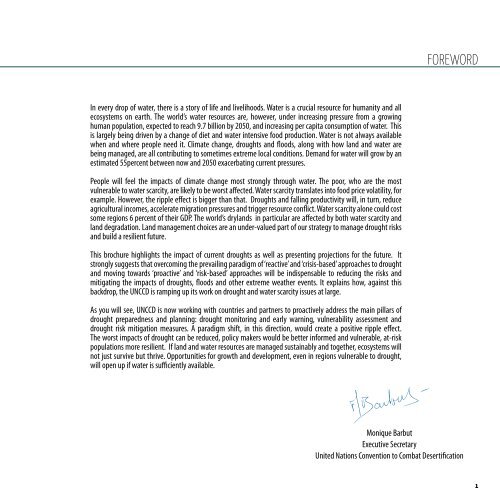The Ripple Effect
2016_Drought_ENG
2016_Drought_ENG
You also want an ePaper? Increase the reach of your titles
YUMPU automatically turns print PDFs into web optimized ePapers that Google loves.
foreword<br />
In every drop of water, there is a story of life and livelihoods. Water is a crucial resource for humanity and all<br />
ecosystems on earth. <strong>The</strong> world’s water resources are, however, under increasing pressure from a growing<br />
human population, expected to reach 9.7 billion by 2050, and increasing per capita consumption of water. This<br />
is largely being driven by a change of diet and water intensive food production. Water is not always available<br />
when and where people need it. Climate change, droughts and floods, along with how land and water are<br />
being managed, are all contributing to sometimes extreme local conditions. Demand for water will grow by an<br />
estimated 55percent between now and 2050 exacerbating current pressures.<br />
People will feel the impacts of climate change most strongly through water. <strong>The</strong> poor, who are the most<br />
vulnerable to water scarcity, are likely to be worst affected. Water scarcity translates into food price volatility, for<br />
example. However, the ripple effect is bigger than that. Droughts and falling productivity will, in turn, reduce<br />
agricultural incomes, accelerate migration pressures and trigger resource conflict. Water scarcity alone could cost<br />
some regions 6 percent of their GDP. <strong>The</strong> world’s drylands in particular are affected by both water scarcity and<br />
land degradation. Land management choices are an under-valued part of our strategy to manage drought risks<br />
and build a resilient future.<br />
This brochure highlights the impact of current droughts as well as presenting projections for the future. It<br />
strongly suggests that overcoming the prevailing paradigm of ‘reactive’ and ‘crisis-based’ approaches to drought<br />
and moving towards ‘proactive’ and ‘risk-based’ approaches will be indispensable to reducing the risks and<br />
mitigating the impacts of droughts, floods and other extreme weather events. It explains how, against this<br />
backdrop, the UNCCD is ramping up its work on drought and water scarcity issues at large.<br />
As you will see, UNCCD is now working with countries and partners to proactively address the main pillars of<br />
drought preparedness and planning: drought monitoring and early warning, vulnerability assessment and<br />
drought risk mitigation measures. A paradigm shift, in this direction, would create a positive ripple effect.<br />
<strong>The</strong> worst impacts of drought can be reduced, policy makers would be better informed and vulnerable, at-risk<br />
populations more resilient. If land and water resources are managed sustainably and together, ecosystems will<br />
not just survive but thrive. Opportunities for growth and development, even in regions vulnerable to drought,<br />
will open up if water is sufficiently available.<br />
Monique Barbut<br />
Executive Secretary<br />
United Nations Convention to Combat Desertification<br />
1


